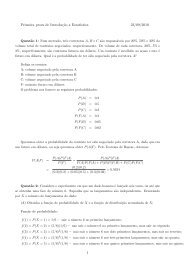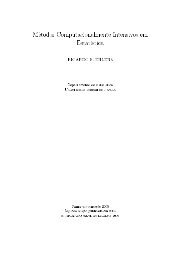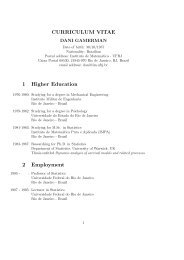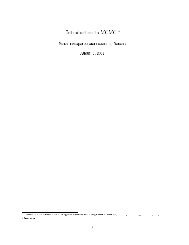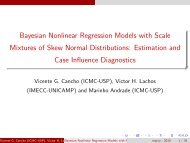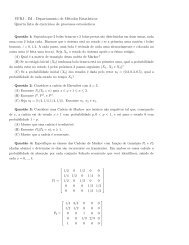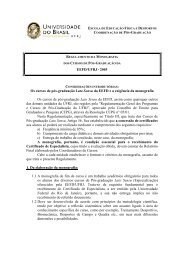Copulas: a Review and Recent Developments (2007)
Copulas: a Review and Recent Developments (2007)
Copulas: a Review and Recent Developments (2007)
Create successful ePaper yourself
Turn your PDF publications into a flip-book with our unique Google optimized e-Paper software.
(1999)) even in the cases where the associated distributions are discontinuous. Besides,the TVaR is characterized as a solution of a optimizing problem. The basiccontribution in Rockfellar <strong>and</strong> Uryasev (2000, 2002) is the following. They present apractical method of optimization to evaluate TVaR <strong>and</strong> VaR simultaneously whichis convenient in evaluation derivatives, (options, futures), market, operational credit<strong>and</strong> risk, ¯nancial risk, etc. Note that TVaR uses only the upper tail distributioninformation. Nevertheless, TVaR is not adequate to extreme events, i.e. in the caseof \low frequencies <strong>and</strong> high losses". Interesting applications of the above theorem incase of TVaR <strong>and</strong> for a class of distortion risk measures suggested by Wang (2000)<strong>and</strong> discussed by Darkiewicz et al. (2005) <strong>and</strong> Goncalves et al. (2005).3 Several new methods of copula modellingIn this section we discuss three topics related to our current research <strong>and</strong> show someof results obtained.3.1 Order statistics copulaThere are very few results in literature relating the order statistics <strong>and</strong> associatedcopulas. The r<strong>and</strong>om variables max(X; Y )<strong>and</strong>min(X; Y ) are the order statistics forX <strong>and</strong> Y . Then, P (max(X; Y ) · t) =C(F (t);G(t)), e.g. Nelsen (1999), p. 25, <strong>and</strong>P (min(X; Y ) · t) =F (t)+G(t) ¡ C(F (t);G(t)):The above relations are generalized by Georges et al. (2001) as follows: Let(X 1 ;::: ;X n )beasetofcontinuousr<strong>and</strong>omvariableswithF Xi (x) =P (X i · x); i=1; 2;::: ;n: Denote by C n the associated copula <strong>and</strong> let X r:n be r-th order statistic(1 · r · n). Then its distribution function F r:n (t) =P (X r:n · t) isgivenbynXF r:n (t) = (¡1) k¡l k()l X #C n (v 1 ;::: ;v n ) ;" kXk=r l=rwhere P denotes summation over the set((v 1 ;::: ;v n ) 2 [0; 1] n j v i 2fF Xi (t); 1g;)nX± f1g (v i )=n ¡ kwith ± f1g (v i )=1ifv i =1,<strong>and</strong>0otherwise. Forr = 1 the last formula givesi=1F 1:n (t) =1¡ C n (S X1 (t);::: ;S Xn (t));where C n is the survival copula <strong>and</strong> S Xi (t) =1¡ F Xi (t); i=1;::: ;n.Wealsonotethat X n:n = max(X 1 ;::: ;X n ) <strong>and</strong> its distribution function is the diagonal section ofthe multivariate distribution F n:n (t) =C n (F X1 (t);:::;F Xn (t)).19




